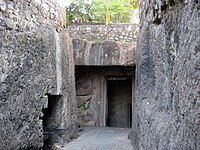Jogeshwari Caves
This article needs additional citations for verification. (December 2017) |
| Jogeshwari Caves | |
|---|---|
 Jogeshwari caves interior | |
| Location | Jogeshwari (E), Mumbai |
| Coordinates | 19°08′21″N 72°51′24″E / 19.1391°N 72.8568°ECoordinates: 19°08′21″N 72°51′24″E / 19.1391°N 72.8568°E |
| Elevation | 15 m (49 ft) |
| Entrances | 3 |
| Difficulty | easy |
The Jogeshwari Caves are some of the earliest Buddhist cave temples sculptures located in the Mumbai suburb of Jogeshwari, India. The caves date back to 520 to 550 CE.[citation needed] These caves belongs to the Hindus daity Jogeshwari]] . According to historian and scholar Walter Spink, Jogeshwari is the earliest major cave temple in India and (in terms of total length) "the largest".[1]
The caves are located off the Western Express Highway, and are surrounded by encroachments. The caves are accessed through a long flight of stairs into the main hall of this cavernous space. It has many pillars and a Lingam at the end. Idols of Dattatreya, Hanuman, and Ganesh line the walls. There are also relics of two doormen. The cave also has a murti and footprints of goddess Jogeshwari (Yogeshwari), whom the area is named after. The goddess is considered a Kuladevi by some Marathi people, and also worshipped by some migrant groups from Gujarat.
Gallery[edit]
References[edit]
- ↑ Walter M. Spink; University of Michigan. Center for South and Southeast Asian Studies (1967). Ajanta to Ellora. Marg Publications. Retrieved 19 April 2012.
External links[edit]
- Wikipedia cave articles with unreferenced coordinates
- Articles with unsourced statements from December 2017
- Buddhist temples in India
- Hindu temples in Mumbai
- Hindu cave temples in India
- Buddhist caves in India
- Buddhist monasteries in India
- Indian rock-cut architecture
- Former populated places in India
- Buddhist pilgrimage sites in India
- Caves containing pictograms in India
- 6th-century Hindu temples
- 6th-century establishments in India
- Gupta art
- Buddhism stubs
- Indian religious building and structure stubs



